- LCMS vs LMS: main differences
- The challenges of traditional sales training methods
- Benefits of using a LCMS for sales training
- How to use LCMS to enhance sales training
- Integrate with CRM to align with business goals
- Key features to look for in an LCMS for sales training
- Advantages of custom-built LCMS
- LCMS for your sales team — best practices
- Conclusion
You know that effective sales training is vital for business success. But delivering impactful programs at scale across a dynamic salesforce is easier said than done. That's where a learning content management system (LCMS) can make all the difference.
In this article, we'll explore the key capabilities of an LCMS and why it's an essential tool for sales enablement leaders aiming to drive revenue growth through continuous skills development.
In this article:
The importance of LCMS
Effective training is essential for any business's success, and sales training is particularly crucial. Investing in sales training translates directly to a more skilled and productive sales team. On average, sales training can boost sales representatives' performance by up to 20%
However, traditional approaches to sales training, such as in-person workshops, often face challenges like time constraints, lack of consistency, and disengagement. However, a well-organized Learning content management system (LCMS) can help overcome these challenges and enhance sales training.
What is a learning content management system?
LCMS is a software application that helps organizations create, store, manage, and deliver training materials in a centralized location. Think of a learning content management system (LCMS) as a comprehensive library specifically designed for managing and delivering training materials. It goes beyond simply storing content and provides functionalities to organize, distribute, and track the learning process for your sales team.
LCMS vs LMS main differences
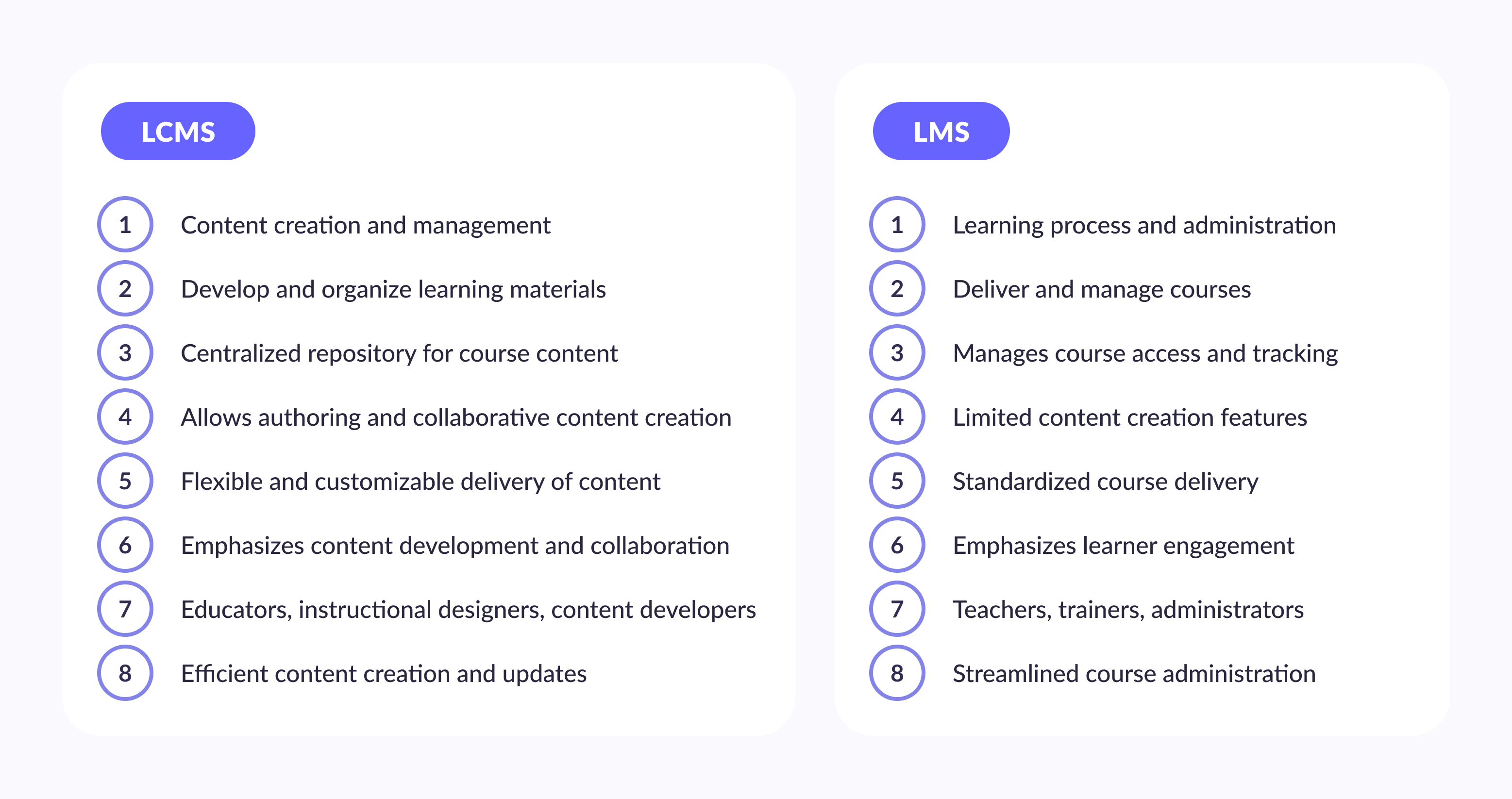
While both learning content management systems (LCMS) and learning management systems (LMS) play a role in eLearning, they have distinct strengths and target audiences. Here's a breakdown of the main differences between LCMS and LMS:
Focus
LCMS: Primarily focused on creating and managing learning content. It provides tools for authoring, editing, storing, and organizing training materials.
LMS: Designed for delivering and managing the learning experience. A learning content management system tracks learner progress, administers assessments, and facilitates communication between instructors and learners.
Target users:
LCMS: Content creators, instructional designers, subject matter experts who develop and manage training materials.
LMS: Training managers, instructors, and learners who access and participate in training programs.
Core functionalities
LCMS:
- Content creation tools (e.g., video editing, SCORM authoring)
- Content version control
- Collaboration features for content development teams
- Integration with multimedia resources
- Reusability of content across different learning programs
LMS:
- User registration and enrollment management
- Course delivery and content management
- Learning paths and curriculum creation
- Learner performance tracking (e.g., completion rates, assessment scores)
- Reporting and analytics on learning outcomes
- Communication tools like discussion forums and messaging
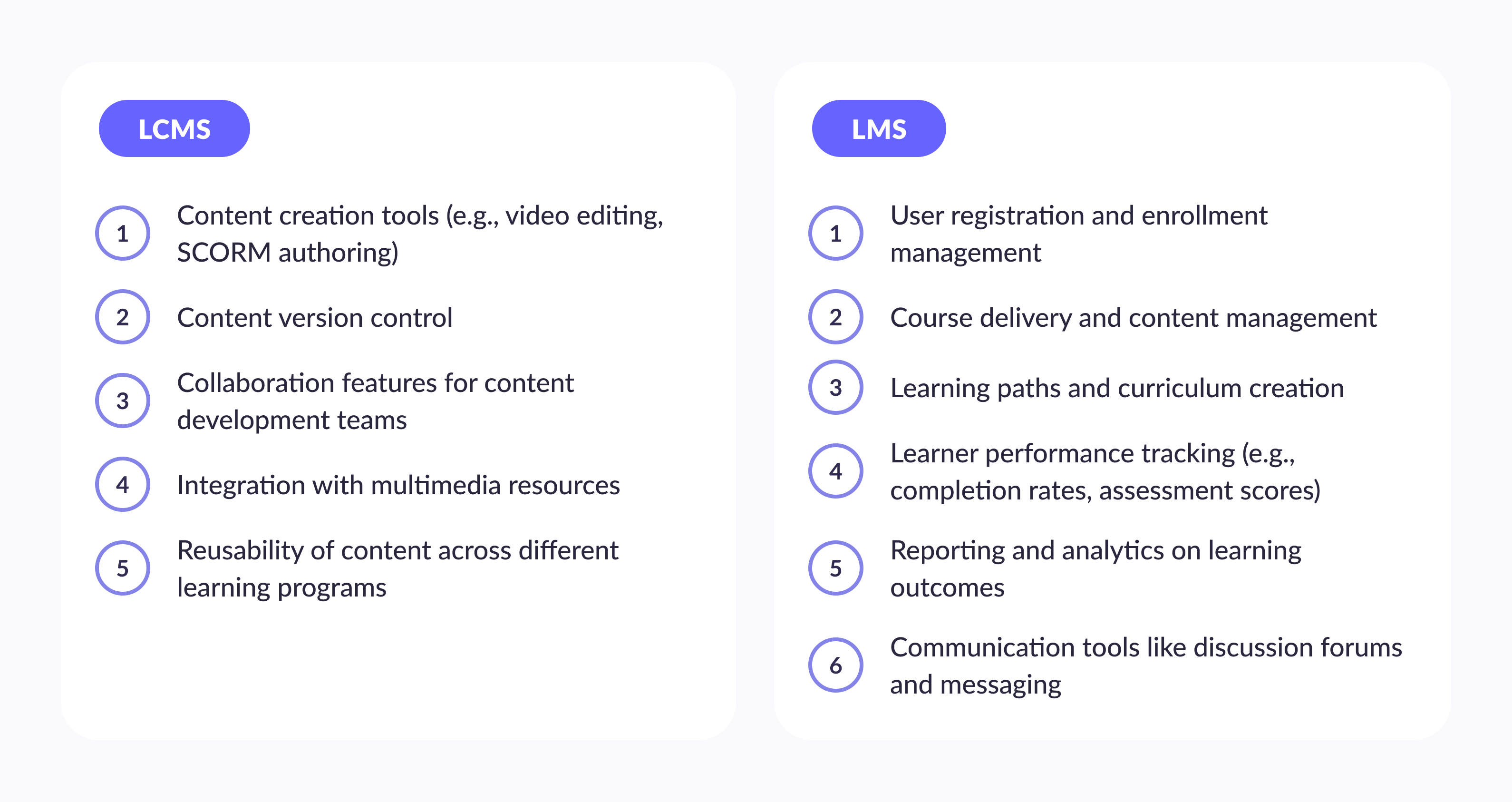
Overlap and complementarity
While distinct, LCMS and LMS can work together seamlessly. LCMS-created content can be uploaded and delivered through an LMS. Some LMS platforms offer basic content creation tools, blurring the lines a bit.
Choosing between LCMS and LMS:
- If your primary need is to develop and manage high-quality training content, an LCMS is a better fit.
- If your focus is on delivering and administering training programs, an LMS is the preferred choice.
Many organizations benefit from implementing both an LCMS and LMS for a comprehensive eLearning solution.
The challenges of traditional sales training methods

Traditional sales training techniques like classroom lectures and role-playing often fail to achieve optimal results. These antiquated methods cannot keep up with the fast-paced changes in technology, sales processes, and customer expectations. Here are some key challenges associated with these methods:
Lack of scalability
Classroom training requires scheduling instructors and physical spaces, limiting the frequency and availability of courses. This makes it difficult to train large sales teams or frequently update materials. In contrast, a learning content management system offers on-demand, scalable digital content that can reach all reps whenever needed.
Inconsistent messaging
With various instructors and limited oversight, the information delivered in classroom training can be inconsistent or omit key points. A learning content management system centralizes content creation to ensure reps receive the same, comprehensive messaging about products, services, processes, and company values.
Difficulty measuring ROI
While classroom training may seem engaging, it often fails to provide concrete metrics proving its effectiveness. An LCMS tracks reps’ progress and performance to show how content impacts KPIs like sales productivity, product knowledge, and customer satisfaction.
Outdated content
Sales training content, especially about technology or processes, becomes outdated quickly. However, updating physical materials and retraining instructors requires significant resources and time. A learning content management system simplifies updating information, allowing sales enablement teams to keep content current and optimize reps’ performance.
An LCMS addresses all these challenges through on-demand digital content, centralized creation and management, data-driven insights, and streamlined updating.
For today’s sales organizations, an LCMS is essential to the success and impact of sales training programs.
Benefits of using a LCMS for sales training
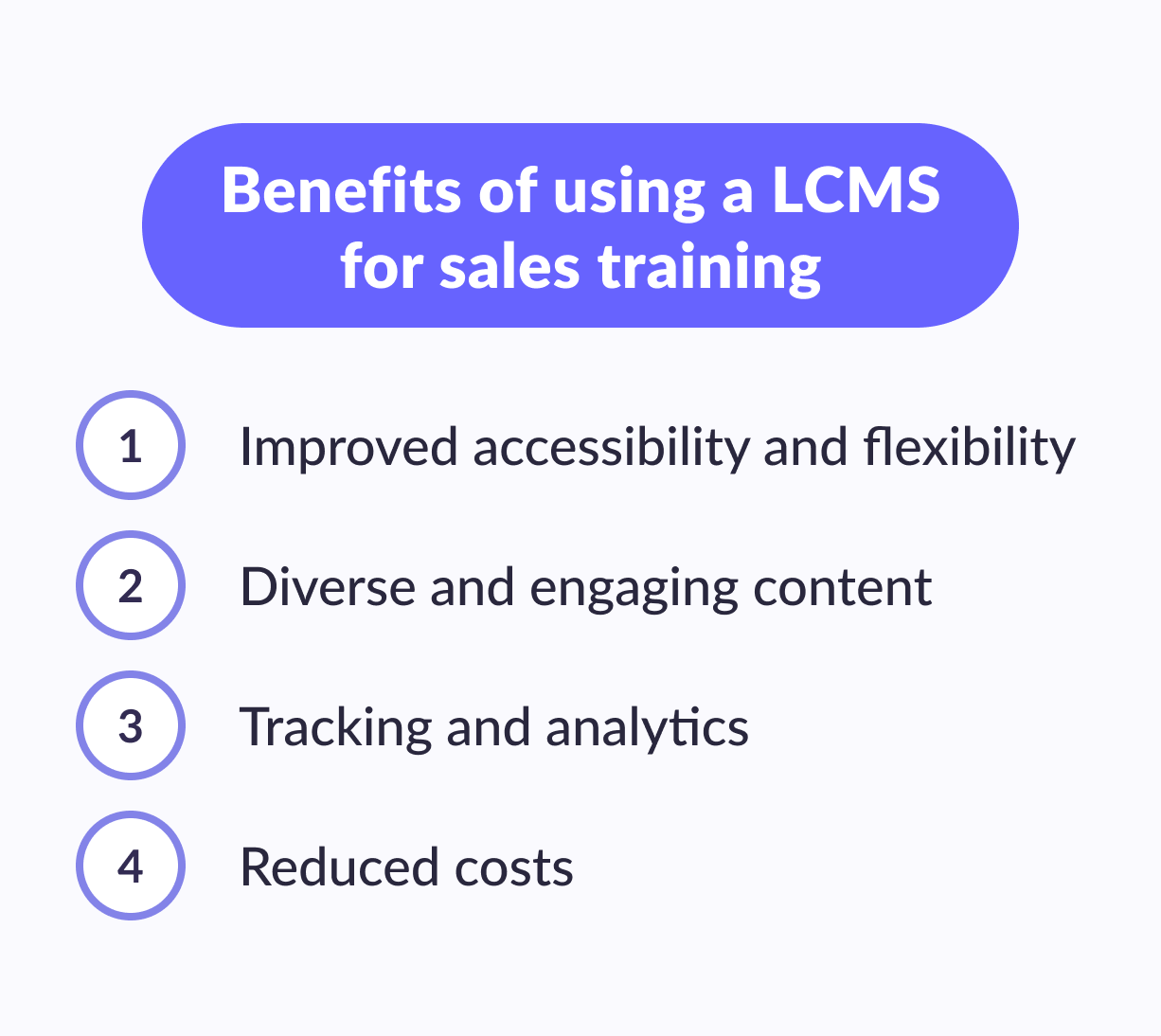
A LCMS provides numerous advantages for sales training programs.
Improved accessibility and flexibility
With an LCMS, content can be accessed on any device at any time. This allows sales reps to review training materials whenever needed and accommodates different learning styles.
The system’s flexibility also makes it easy to update content and push changes in real time.
Diverse and engaging content
An LCMS supports diverse content formats like videos, simulations, quizzes, and gamification to keep sales reps engaged. This multimedia approach is more impactful than traditional methods. The engaging content also leads to improved knowledge retention which is essential for sales roles.
Tracking and analytics
An LCMS provides detailed analytics on content usage, completion rates, and assessment scores. This data gives visibility into how sales reps are interacting with the training content. Managers can then make data-driven decisions to optimize the program and drive better business outcomes.
Reduced costs
With an LCMS, content can be re-used and re-purposed which reduces development costs over time. The system also minimizes the need for in-person training sessions and travel reducing associated expenses. Overall, an LCMS leads to a high return on investment for sales enablement and training programs.
How to use LCMS to enhance sales training
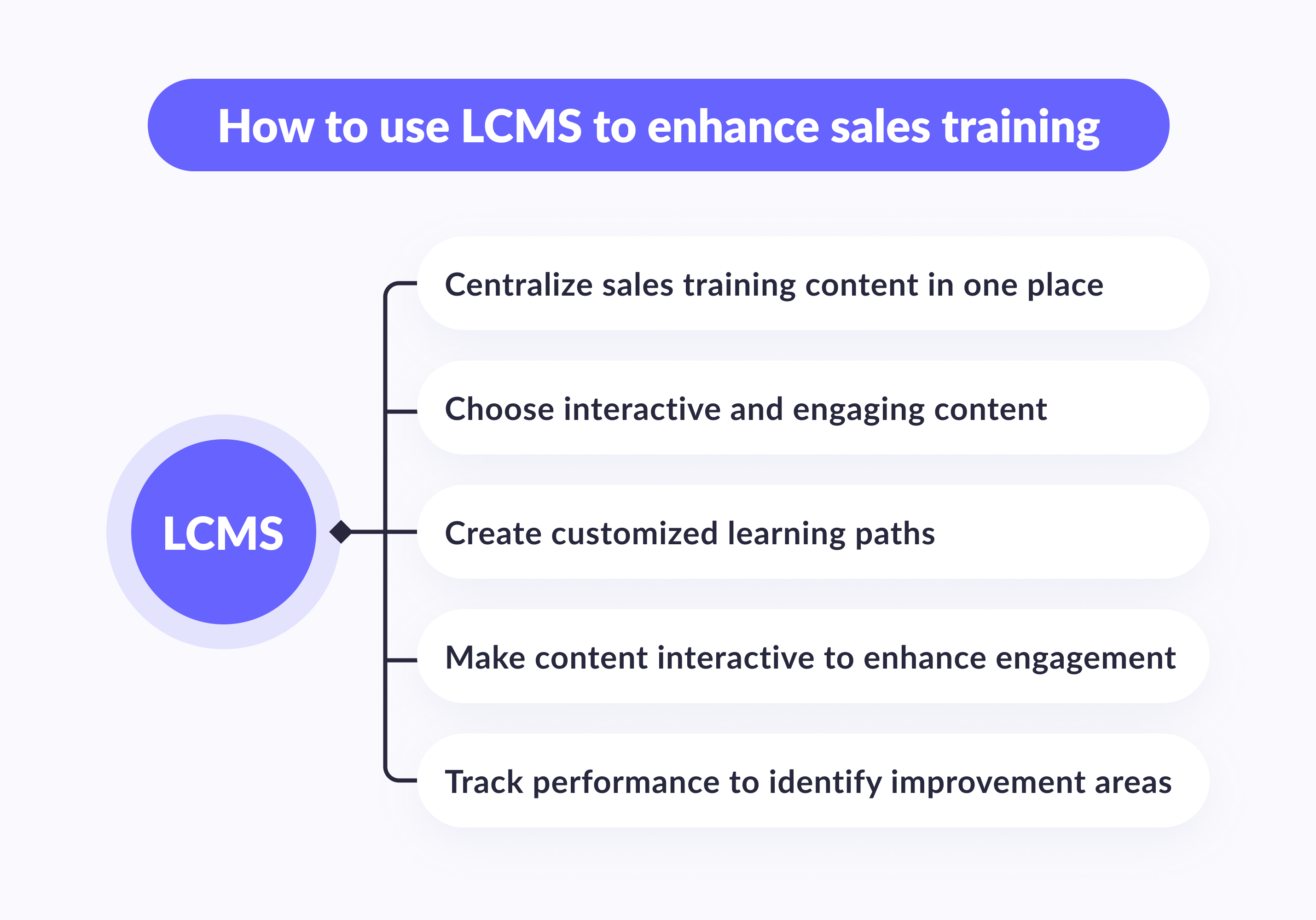
Centralize sales training content in one place
An LCMS gives you a single place to store all your sales training materials, from presentations and videos to workbooks and reference guides. No more hunting through file servers or email attachments to find the latest versions. Your reps always have access to up-to-date, approved content, and you have peace of mind knowing any outdated materials have been removed.
Keep content organized and searchable
Within the LCMS, you can organize content by topic, role, region, or whatever structure makes sense for your needs. Intuitive search features make it easy for reps to find what they need when they need it. They can even save favorite materials or create personalized playlists for quick access.
Streamline content creation and updates
A good LCMS simplifies content creation with templates, workflows, and versioning to standardize materials and enable collaboration.
Subject matter experts can easily make updates, and you have full control and visibility over the content approval process. Any changes made are automatically updated across the system, so you never have to worry about inconsistent or outdated information.
Choose interactive and engaging content
Static presentations and wordy workbooks won't hold the interest of experienced sales reps. An LCMS gives you options to incorporate interactive content like:
- Video examples of prospecting calls or product demos
- Simulations that allow reps to practice their skills in a virtual environment
- Quizzes and knowledge checks to reinforce learning
This interactive content leads to better engagement and retention, especially when combined with traditional materials. Reps can then immediately apply their new knowledge, and you gain insight into their progress and comprehension.
Create customized learning paths
A one-size-fits-all approach won’t work for sales training. An LCMS lets you create customized learning paths based on an individual’s role, experience level, and learning needs.
Map content to expertise
Group your sales team into levels like “new hire,” “seasoned rep,” and “account executive.” Then, map relevant content to each level. New hires may focus on product knowledge and soft skills, while account executives sharpen negotiation techniques and industry trends. This targeted approach ensures reps learn what they need to know at the right time.
Enable self-selection
Within each learning path, allow reps to choose topics that interest them. Some may want to dive deep into a new product feature, while others prefer refining objection handling skills.
Giving reps control over their learning boosts motivation and engagement. They can follow suggested paths or forge their own way.


Thank you for Subscription!
Make content interactive to enhance engagement
Include interactive content like quizzes, simulations, and branching scenarios.
For example, a quiz on compliance policies helps reinforce key points, while a simulation of a difficult client meeting allows reps to apply new skills in a risk-free environment.
These engaging elements transform passive learning into an active experience, resulting in higher retention and job performance.
Quizzes
Including quizzes in your sales training content is an excellent way to reinforce key concepts and ensure your team retains the information. Quizzes provide opportunities for practical application of knowledge in a low-pressure environment.
You can design quizzes focused on product details, objection handling, prospecting techniques, or any other area you want to emphasize. Offer quizzes at the end of modules or chapters to help salespeople gage their understanding before moving on.
Simulations
Nothing prepares salespeople for live interactions like simulations. Create hypothetical scenarios reflecting situations they may encounter, then have learners walk through how they would handle them.
This allows them to apply new skills in a virtual environment and gain valuable experience before facing prospects. You might develop simulations focused on initial calls, presentations, dealing with objections, and closing deals.
Embed simulations directly in your LCMS so they are easy to access and automatically saved as progress is made.
Gamification
Adding game elements to your sales training, like points, badges, and leaderboards, helps motivate learners and fuels their competitive spirit.
For example, you can award points for completing quizzes, simulations, and other interactive content. Let salespeople earn badges as they achieve milestones.
Display leaderboards showing top performers to inspire the whole team. Gamification taps into psychological rewards that stimulate engagement and give salespeople incentives to keep learning.
Mobile access
Today’s salespeople are often on the go, so enabling mobile access to your LCMS is essential. With a mobile-friendly system, they can log in and continue their training anytime using a smartphone or tablet.
Mobile access makes learning more convenient and flexible, allowing salespeople to advance through the training at their own pace.
Track performance to identify improvement areas
Once your sales team starts going through the training, it’s important to monitor their progress. An LCMS allows managers to track completion rates for courses and assessments, evaluate scores and response times, and identify topics that may need review.
Monitor course completion
You’ll want to ensure all sales reps complete required training materials. An LCMS tracks who has finished interactive courses, videos, readings, and other content. Managers can then follow up with anyone falling behind to offer additional support.
Review assessment scores and response times
Quizzes, tests, and simulations embedded in the LCMS provide insight into how well the team is grasping key concepts. Look for scores that seem lower than expected and topics many reps are struggling with. Also, analyze average response times, as quicker responses could indicate uncertainty or guessing. Use this data to make improvements to the content or delivery methods.
Identify knowledge gaps
Are there certain product features, services, or sales techniques many reps don’t fully understand? An LCMS makes it easy to spot these knowledge gaps so you can address them. You might need to revisit these topics in a live training session, provide additional resources, or make the existing content more engaging and interactive.
Offer individualized guidance
While the LCMS provides a standardized curriculum, it also allows for customized learning paths based on a sales rep's role, experience, strengths, and weaknesses.
Managers can assign specific courses or learning activities to help reps improve in key areas or advance their skills. The performance tracking features then help determine if the customized guidance is effective.
Using the metrics and insights provided by your LCMS, you can continuously enhance your sales training program.
Make improvements to content, delivery methods, and learning paths so your reps have the knowledge and skills they need to succeed. An optimized training program will boost morale, increase productivity, and positively impact your bottom line.
Ensure access to up-to-date materials
Sales and marketing teams should regularly review and refresh materials to reflect changes in the product lineup, pricing, positioning, and more.
An LCMS makes it easy to update documents, presentations, videos, and other assets, then automatically notifies users of the changes. No more chasing down reps to distribute updates or worrying they’re working off outdated content.
Integrate with CRM to align with business goals
Integrating an LCMS with your CRM system helps align sales training with key business objectives. As deals progress through the sales pipeline, the LCMS can push relevant training content to reps.
For example, if a lead enters the proposal stage, the system may prompt reps to review pricing strategy and negotiation tactics. When a new product launches or features get updated, the LCMS can automatically assign training to ensure reps have the latest knowledge.
While an LCMS enhances sales training on its own, integration with a CRM makes that training directly relevant to your organization’s needs and goals. Together, these technologies provide a self-reinforcing mechanism to educate sales representatives, evaluate their progress, and refine programs to optimize effectiveness. Integrating systems may require initial investment, but the long term benefits to productivity and revenue far outweigh the costs.
Key features to look for in an LCMS for sales training
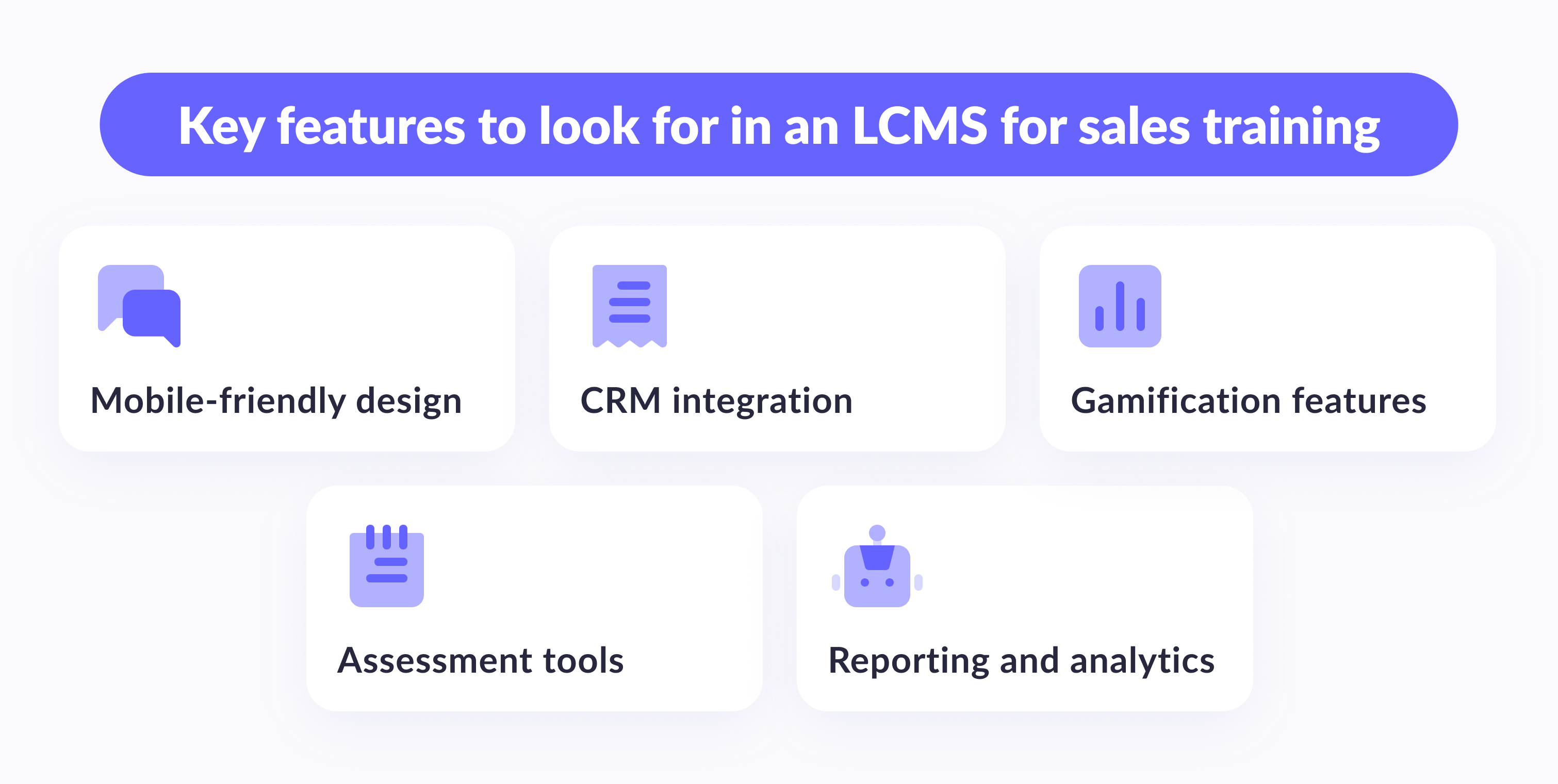
Mobile-friendly design
An LCMS with a responsive, mobile-first design will allow your sales team to access training content anytime, anywhere.
CRM integration
Integrating an LCMS with your customer relationship management (CRM) system provides a seamless learning experience for sales representatives.
Gamification features
Gamification techniques like points, badges, levels, and leaderboards can motivate sales reps to engage with an LCMS by making learning feel more fun and rewarding.
Assessment tools
An LCMS should offer tools to evaluate sales reps’ learning and competencies, such as quizzes, tests, simulations, and virtual role plays.
Reporting and analytics
Analytics empower sales managers to identify opportunities, demonstrate the impact of learning initiatives, and make data-driven decisions to enhance the effectiveness of training.

More on the topic
How to build a learning management system (LMS) from scratch
In this article, you will find answers about how to build an LMS, the average cost, benefits, main development steps, and more.
Learn moreAdvantages of custom-built LCMS
An LCMS built specifically for your needs can have features that perfectly match your unique training content and delivery methods. Off-the-shelf solutions might require workarounds or lack functionalities you require.
Scalability: a custom LCMS can be designed to scale with your organization's growing training needs. You won't be limited by the capabilities of a pre-built system.
Security: with a custom LCMS, you have complete control over user access and data security. This can be crucial for companies dealing with sensitive information in their training materials.
Integration: a custom LCMS can be seamlessly integrated with your existing Learning Management System (LMS) or other enterprise applications. This can streamline workflows and improve data sharing.
Ready to unlock the full potential of your training programs?
At Geniusee, we specialize in custom development of LCMS solutions. Our experienced team of developers will work closely with you to understand your unique training needs and design a custom LCMS that perfectly aligns with your goals.
Check out our LCMS development services today.
LCMS for your sales team — best practices
Identify training needs
To implement an effective learning and content management system for your sales team, first analyze sales performance data and conduct needs assessments to determine specific skill gaps and areas for improvement. Tailor learning content to address trends in your industry and company objectives. Develop a curriculum that builds competencies in a logical progression.
Develop engaging learning modules
Break down complex sales concepts and processes into bite-sized, interactive modules. Each module should have clear learning objectives and take no more than 10-15 minutes to complete. Incorporate interactive elements like quizzes, simulations, and case studies to make the content engaging and impactful.
Incorporate real-world scenarios
Use real-world examples, case studies, customer testimonials, and role-playing scenarios to demonstrate how lessons apply in practice. This helps salespeople translate knowledge into action by exposing them to realistic situations they will encounter. Allow opportunities for discussion and feedback to strengthen understanding.
Facilitate collaboration and knowledge sharing
An LCMS should encourage social and experiential learning. Discussion forums, online mentoring, and peer feedback allow salespeople to learn from each other. Consider gamifying elements of the platform to increase participation and make learning fun.
By enhancing your sales training strategy with an LCMS, you equip your team with the skills and knowledge to achieve exceptional results.
Conclusion
You have now seen the power of learning content management systems for sales training. By centralizing your content, tracking usage, and enabling personalization, learning content management systems elevate sales enablement.
Rather than cobbling together disjointed resources, you can deliver unified, targeted training. This allows your reps to ramp up faster and retain knowledge better. The result is increased sales productivity, revenue growth, and happier customers.
With the right LCMS solution, your sales training can be transformed. You owe it to your team and company to explore if an LCMS is right for you. The investment will pay dividends as your salesforce grows into an unstoppable revenue machine. Act now to get started on the path to sales training success.





















